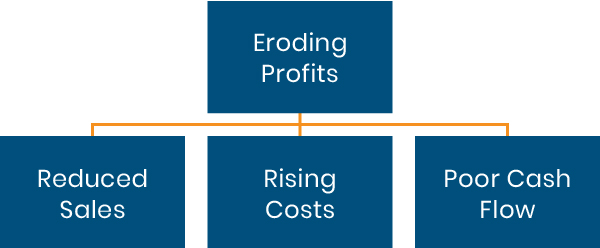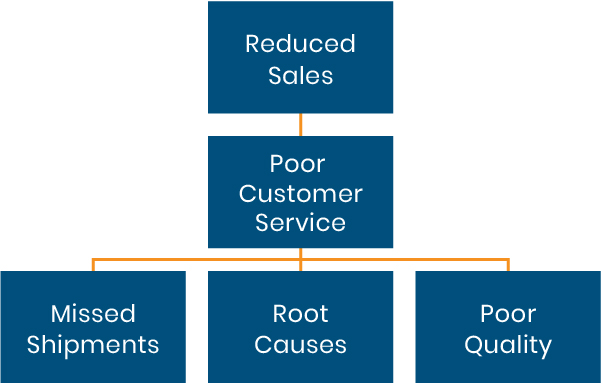Customer Service for manufacturers and distributors has evolved beyond the original focus of timely delivery and product quality to include at least customer engagement, education, and self-service during a time of reduced face to face selling. Unfortunately, your business systems may not have evolved in tandem with these shifts.
It’s Complicated
Manufacturing and distribution companies are the most complex of all business types. No other types of businesses must manage the range of products, costs, prices and customers. Add to this the evolution of customer interactions ranging from face-to-face selling to self-service, real time response expectations via the web, which make it even more challenging. Organizations have struggled to adapt to this new reality and so have enterprise resource planning (ERP) vendors.
In response, companies have implemented customer relationship management (CRM) systems. Unfortunately, this has resulted in disjointed sets of customer information spread between the CRM and ERP systems.
Let’s consider how this situation affects two of the most common business issues:
Where’s my order?
First, a brief recap from our blog, Six Dysfunctions of a Manufacturing Business. Relying on Alan Luber’s excellent book Solving Business Problems with MRP II, below is a schematic of the how each of the core business problems link together and ultimately affect company profits.

Drilling into the schematic for reduced sales yields this:

Reduced sales are a cumulative result of poor customer service. Certainly, reduced sales are a direct consequence of missed shipments—we can’t invoice for a non-shipment. Inferior quality can affect customer satisfaction, resulting in reduced orders. Both business problems have underlying causes. Finally, there may be very specific company issues (lack of sales training, cumbersome order processes, payment terms, etc.) directly affecting customer service. These are grouped under root causes.
Using the broad category of missed shipments, here are some common issues:
- Not delivering on the date committed to the customer
- Not delivering what was quoted—configuration, quantity, full order, etc.
- Not notifying customers of changes in date/quantity/delivery method
Item #1 is most often due to poor production/supply planning, lack of solid inventory information and the inability to commit available supply to a specific customer order. Lacking this capability to allocate existing or planned inventory to specific customer requirements can be either due to a limitation of the ERP system or the failure to coordinate sales and production plans within the ERP system.
Item #2 is often due to quoting and configuration being performed by sales outside of the ERP system or within the CRM system but not synchronized with the ERP system. The slow and inaccurate transfer of quotation and configuration data to systems results in incomplete or wrong product being supplied, necessitating rework or returns. In addition, rarely is there a straightforward way to review the actual profitability of an order, or set of orders, comparing actual supplied cost versus the original quote.
Finally, item #3 is related to communication. Customers expect to have the ability to check on order status via a website as well as receive notification, e.g., by email, when order status changes. Unfortunately, most of that information is deep within the ERP system database with no easy way to access it via the web.
Who is a happy and good customer?
One of the most difficult challenges the sales team has is gaining a complete picture of all customer interactions with your company. Nothing can be more humbling to an unaware sales person than to have a customer, during an annual account review, list the many complaints they have experienced with your company. Another issue is understanding how much business your current customer is doing with you. Getting this information requires both a corporate culture of accountability and an ability to extract information from multiple sources.
More challenges:
- Which customers should your company focus on? Which should you consider “firing”?
- Are my key customers buying more of the same products than last year?
- Are they buying more of all products this year versus last year?
- Have we recorded any complaints from them? Can they log those complaints on our web site?
- How does that compare with last year or our other customers?
- What are those complaints and what was our response?
- Did we win a greater percentage of quotes this year versus last year?
- Why did we lose customers?
Mature CRM system users will capture some of these customer interactions, but that is not enough. Often the information required to understand customer satisfaction, and hence customer spend, is a combination of insights gathered within the CRM system coupled with analysis from the ERP system.
Very few ERP systems are designed to work well with a separate CRM system and almost no ERP systems have particularly good CRM modules. Consequently, it can be challenging to configure these systems to align and create the dashboard views the sales organization requires.
How good is your company?
Consider a few of these points in assessing your own organization:
- On what percentage of customer orders can a delivery commitment be made on initial request? 90% or above is expected.
- What is your on-time delivery performance? ~90% is considered good.
- Do you know what percentage of requested delivery dates you can satisfy?
- Do your sales people have a real-time view (dashboard or report) by customer of delivery performance and customer issues and resolutions? Does that include past and current order rates (total, product family, etc.)?
Improving Customer Service with CRM and ERP Integration
It is possible to greatly improve your customer service by providing the right information in a timely way to your customer facing staff. Operational and organizational changes will likely be necessary as well as changes to the supporting systems. For most companies, it will be vital to marry the CRM and ERP systems and to use an experienced business partner who understands the best way to do so.
Contact us for more information about how OnActuate can support your ERP and CRM integration to improve customer service.







